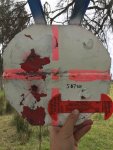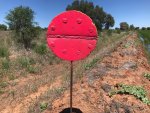I went with fluorescent yellow and it actually is hard to see due to the grass being dead. What is everyone fav color? I was think maybe hi vis orange next time. im using it between 600-1000 yds
Join the Hide community
Get access to live stream, lessons, the post exchange, and chat with other snipers.
Register
Download Gravity Ballistics
Get help to accurately calculate and scope your sniper rifle using real shooting data.

Install the app
How to install the app on iOS
Follow along with the video below to see how to install our site as a web app on your home screen.
Note: This feature may not be available in some browsers.
You are using an out of date browser. It may not display this or other websites correctly.
You should upgrade or use an alternative browser.
You should upgrade or use an alternative browser.
Whats the best color to paint steel targets
- Thread starter Sniperwannabee
- Start date
I woukd go with white. The matches I've shot, the targets are probably 90-95% white and 5-10% red or blue.
Whether or not that helps you, I have no idea.
Whether or not that helps you, I have no idea.
White is the most reflective color, and very little in nature is white. It just follows it will stand out the most and be easiest to spot.
I just assumed that the only reason not to paint them white is in a comp so as not to confuse targets...
I just assumed that the only reason not to paint them white is in a comp so as not to confuse targets...
Blaze Orange might be my second choice. Seems like I can see a MFer three ridges (miles) away walking in orange during deer season.
Unpainted, lead spattered grey. Cause that's what you're going to get in a match. 
Inverted striping paint in white is thicker than normal rattle cans and works well for me. I will hit them with other florescent colors first, then the white over that to re-create a shoot-n-see effect if I feel like making an effort.
The most important thing is being able to see your target, IMHO. That means it needs to stand out against its background. An orange target against a green or blue background can be enhanced by using glasses with a slight reddish tint to them. Light yellow glasses will help under twilight conditions. Everyone's eyes are a little different in terms of perceiving color renditions and contrast. An ophthalmologist can help you select various glass tints to help with varying conditions. They actually have tools for this.
Trap shooters all have their preferences for eye protection and helpful tints, the guys who are really good at it pay the money to get their eyes checked. Even clear lenses can benefit from UV blocking coatings for help in picking out targets.
Trap shooters all have their preferences for eye protection and helpful tints, the guys who are really good at it pay the money to get their eyes checked. Even clear lenses can benefit from UV blocking coatings for help in picking out targets.
We're using mostly white but a few shooters at our range prefer black. We had some pink paint but the Cowboy Action group was getting very uppity so the pink got used up on their entire 100+ target presentation.
White... Tried road paint pink and it sucked... They didn't pop at all
Shooting with lots of tall grass
Shooting with lots of tall grass
White with a shot of fluorescent orange on the center. Really makes them stand out
I use white 100% of the time.
Easy to see any time of year as it reflects the most light regardless of a green, brown, tan, yellow background.
The better quality more expensive spray cans are worth it over the $1 cheapies. I get more coverage and thicker layer out of a $3.50 can than 4x $1 cans.
Easy to see any time of year as it reflects the most light regardless of a green, brown, tan, yellow background.
The better quality more expensive spray cans are worth it over the $1 cheapies. I get more coverage and thicker layer out of a $3.50 can than 4x $1 cans.
Unpainted, lead spattered grey. Cause that's what you're going to get in a match.
That’s the truth. I feel like white with splattered grey is the best camo in the world for any environment. That pattern is almost invisible no matter the terrain.
White with a shot of fluorescent orange on the center. Really makes them stand out
Bingo
I ran out of white spray paint one day and only had pink line marking paint that sprays upside down, and I couldn’t get a range reading (1000yds) off it with my Sig Kilo 2000, not sure if it was a spectrum/wavelength issue or just to non reflective as it was a rough matt finish. Just something to consider if using a LRF. Now I’m back to white and small centre dots in a contrasting colour usually red. I have also found if you do a proper surface preparation and paint a few layers of quality paint in a dark colour then hit it hard with cheap white paint you end up with only the white paint coming off when shot.
Attachments
Shit, this exact question was up here a month ago or so.
When I was still teaching SDM's, we had tons of steel (literally) and would setup E, F and pepper poppers out to 1k (600m for the students with an extra few out to 1k for us to fart around with whatever toys we brought to work, which is another story).
When we taught 'em how to spot and range, etc., (they were using ACOGs) one of the important things for determining range was the color of the target contrasted to the background. Basically the brighter the target looks the closer it appears and the darker it is the farther out it appear. Mostly true for warm colors but high chroma colors will also appear closer. For instance, a yellow target against grass will always appear closer than a brown target against grass.
They were learning to use ACOGs and rely on the ranging reticle for the most part, but they also had to do some basic range estimation too (and compare that against the ACOG to give them confidence in that reticle). What was the most interesting was when we'd use a wide range and have targets all over the place. Some were the same distance, different color and chroma. Without the ACOG or some other kind of ranging method other than guesstimation, the targets at the same distance but different colors were almost always figured to be different distances. Of course the two targets cannot be right next to each other.
So we used all kinds of colors, but I recall brown and tan being used the most along with green. Probably because real life targets will likely be wearing those colors.
Bottom line is just beware how the different colors work with respect to range estimation.
IME, bright colors show hits the best with white being the most obvious, provided they expose the steel or leave a good mark when the bullet disintegrates.
When I was still teaching SDM's, we had tons of steel (literally) and would setup E, F and pepper poppers out to 1k (600m for the students with an extra few out to 1k for us to fart around with whatever toys we brought to work, which is another story).
When we taught 'em how to spot and range, etc., (they were using ACOGs) one of the important things for determining range was the color of the target contrasted to the background. Basically the brighter the target looks the closer it appears and the darker it is the farther out it appear. Mostly true for warm colors but high chroma colors will also appear closer. For instance, a yellow target against grass will always appear closer than a brown target against grass.
They were learning to use ACOGs and rely on the ranging reticle for the most part, but they also had to do some basic range estimation too (and compare that against the ACOG to give them confidence in that reticle). What was the most interesting was when we'd use a wide range and have targets all over the place. Some were the same distance, different color and chroma. Without the ACOG or some other kind of ranging method other than guesstimation, the targets at the same distance but different colors were almost always figured to be different distances. Of course the two targets cannot be right next to each other.
So we used all kinds of colors, but I recall brown and tan being used the most along with green. Probably because real life targets will likely be wearing those colors.
Bottom line is just beware how the different colors work with respect to range estimation.
IME, bright colors show hits the best with white being the most obvious, provided they expose the steel or leave a good mark when the bullet disintegrates.
I rotate between white, Black and Florescent Orange depending on where the sun is. The above being mentioned about colour is very correct, be carful of where the sun is as well when determining distance and dead ground.
No field shooting I'm assuming?Bright green with an orange X. The two most visible colors in the spectrum.
I wish I had taken a picture of the invisible green steel I shot at on Sunday... maybe it would show up on a camera phone.
I like bright white (just buy the $3 can, it works 5x better than the $1 stuff) with an orange or pink aiming point.
Really depends on your scenery around the target as to what will work best.
Really depends on your scenery around the target as to what will work best.
I found white hard to spot on smaller steel targets at times. I experimented with several colors including flourecent and found my eye is drawn to red in almost any light.
Similar threads
- Replies
- 1
- Views
- 277
- Replies
- 0
- Views
- 363
- Replies
- 0
- Views
- 503


